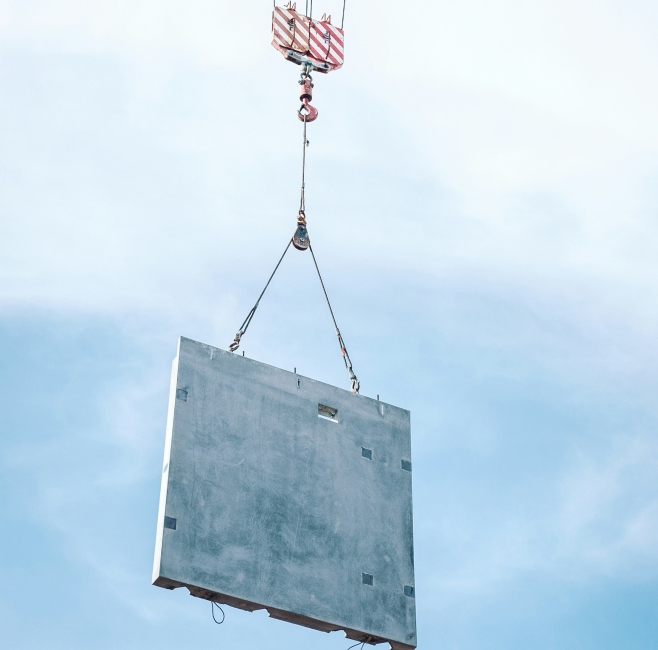Streamline the construction industry
When it comes to on-site production methods, the construction sector still remains relatively untouched by industrialization. The question of industrialization is a long-standing topic, which is re-emerging at a time of economic pressure and environmental crisis. Central to this topic is the democratization of off-site prefabrication for so-called modular construction or building elements , which suggests substantial gains can be made on several levels.
- Faster construction times than traditional on-site construction. Building components in a factory combined with simple on-site assembly first promises to significantly save time. If production methods already used in most other industrial sectors were applied, Bain estimates that modular construction could represent a reduction of between 20 and 50% in construction times.
- More economical. In the same way, off-site prefabrication could mean a significant drop in costs for both builders, whose margins are fragile, and for buyers, who must face a strained market with low rates. McKinsey estimates optimistically about the potential reduction in costs of around 20%.
- More “tolerable” construction sites. Less noise, less dust, less waste and shortened construction site times: off-site construction offers a less invasive future for construction, particularly in urban areas. A study carried out by Make UK Modular and KOPE estimates that prefabricated construction could represent up to 80% fewer vehicle movements to construction sites!
- Environmental gains. By optimizing production methods, off-site construction could finally deliver the promise of dramatically reducing the sector’s emissions, which currently account for 37% of global greenhouse gas emissions throughout the life cycle of structures and buildings. From energy efficiency of building components in a factory, transportation optimization and limiting waste, all studies highlight the environmental gains linked to modular construction. A 2022 study showed that by implementing MMC (Modern Methods of Construction) construction carbon emissions could be cut by 45%.
A question of pragmatism?
Modular construction represents around 4% of current housing stock in the US, 15% of homes in Japan and 45% in Finland, Norway and Sweden. These disparities are due to significant variations in the maturity of modular construction industries, and in their ability to integrate into the “traditional” industrial fabric. The UK-based The Productivity Institute highlights a certain number of obstacles hindering the uptake of MMC: a shortage of new skills, a lack of cohesion between off-site and on-site work, as well as the construction industry’s certain aversion to change.
These obstacles are reinforced by the unstable nature of the sector marked by uncertainty which goes relatively poorly with production chain optimization. With more parties involved in an off-site construction (from the design stage to on-site construction teams), this often creates coordination difficulties which can lead to delays and cost overruns that are difficult to absorb – especially for start-ups.
In this context, Mark Erlich, a Wertheim Fellow at Harvard Law School’s Center for Labor and a Just Economy, calls for some caution, reminding us that “technological innovation in construction has largely followed an evolutionary rather than a disruptive path.” It echoes the analysis of Kévin Cardona, director of entrepreneurial innovation at Leonard, who highlights how effective the most pragmatic approaches could be. “The example of Katerra shows that when a vision is too big – for example, a €100 million gigafactory and a nearby addressable market that is on too small a scale – it is not necessarily the right solution. Projects currently in the works are focusing on the lightest production tools and being closest to demand as possible, to balance production costs and control output prices.” The example of the French company Vestack currently fits this logic.
The ghost of standardization
For buyers – and in particularly elected officials – prefabrication evokes the idea of standardization, something which doesn’t boost development in the sector. “The urban scars of post-war standardization leave a bitter taste in our collective unconscious, particularly in countries such as France, Italy, Germany and Spain which have a strong architectural heritage,” explains Kevin Cardona. In this regard, a recent article in Le Monde highlights the need to “get architects on board” in order to reassure what off-site construction – and particularly modular construction – can bring in terms of creative freedom. In the Design for Modular Construction guide for architects, The American Institute of Architects calls for a change in perception and reiterates that “mass customization” methods today allow for great creative freedom. The guide outlines advances in parametric design tools coupled with BIM and computer-aided manufacturing, which allow designers to make an impact beyond what they thought possible. Finally, the guide states that modular construction is not necessarily an “all-or-nothing strategy” and can be combined very well in a hybrid approach with more traditional construction methods.
Industrialization beyond new builds
Although less intuitive, the idea of using prefabrication techniques other than on new builds is also gaining ground, with EnergiesSprong embodying this trend. Created in the Netherlands in 2010, the initiative consists of retrofitting buildings with prefabricated thermal insulation panels on the outside and is now being emulated throughout Europe. For example, in France, Sogea Atlantique BTP (a subsidiary of VINCI Construction) inaugurated a prefab factory in 2023 which was responsible for retrofitting 296 homes in Maine-et-Loire. Meanwhile in Germany, Ecoworks is implementing AI and robotics for energy-efficiency retrofits. The startup takes a 3D scan of a building, which is then used to create digital twins that serve as the basis for manufacturing the different modules in the factory. “It’s a way of scaling up decarbonization and fostering an inclusive energy transition on housing stock that already comes from a form of industrialization, such as social housing,” explains Kévin Cardona. his process is also at the heart of the design of Rehaskeen panels, an insulation system used by GTM Bâtiment (VINCI Construction) to rationalise, standardise and industrialise energy renovation operations.
Although it has been heralded as a revolution for more than a decade, off-site construction is still relatively unknown and will certainly require the development of new business models if it is to be taken to scale.



